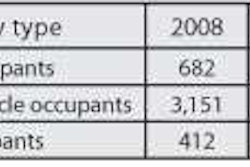Construction work on the final segment of the Interstate 805/SR-905 interchange near the Otay Mesa Port-of-Entry can officially begin, thanks to $20.2 million from the American Recovery and Reinvestment Act. The U.S. Department of Transportation finalized an agreement with Caltrans and the San Diego Association of Governments to fund construction of the six-lane interchange near California’s largest freight border-crossing with Mexico.
Awarded under the TIGER (Transportation Investment Generating Economic Recovery) program, the grant will pay for the completion of access to the Otay Mesa Port-of-Entry’s intermodal connector. The connector is an area that allows shipments to be loaded on and off nearby rail cars without disrupting area traffic and will reduce traffic congestion from commercial trucks.
“This is a terrific example of what the Recovery Act is all about: putting people to work forging a stronger transportation infrastructure,” says U.S. Transportation Secretary Ray LaHood. “Through this Recovery grant, we are helping to improve the safety and efficiency of one of America’s largest ports-of-entry, which in turn will greatly improve the quality of life for San Diego area residents.”
Improvements to the interchange will divert international freight shipping to the SR-905 and away from the heavily congested Otay Mesa Road near San Diego. When completed in 2014, the interchange near the Otay Mesa Port-of-Entry – which accounts for an estimated 1.4 million truck crossings and about $31 billion in goods each year – will improve safety, accommodate significantly more freight shipments and reduce emissions from commercial trucks waiting in traffic to unload cargo.
“Recovery Act funds will improve this interchange and create jobs,” says FHWA Administrator Victor Mendez. “Keeping cross-border shipping free from traffic congestion in San Diego is vital to getting goods to market quickly, creating additional jobs and a stronger U.S. economy.”
The TIGER program, part of the Recovery Act, is designed to promote innovative multimodal and multijurisdictional transportation projects that provide significant economic and environmental benefits to an entire metropolitan area, region or the nation.
The Department announced the selection of $1.5 billion worth of TIGER grants for 51 projects as part of the one-year anniversary of the Recovery Act on Feb. 17.










